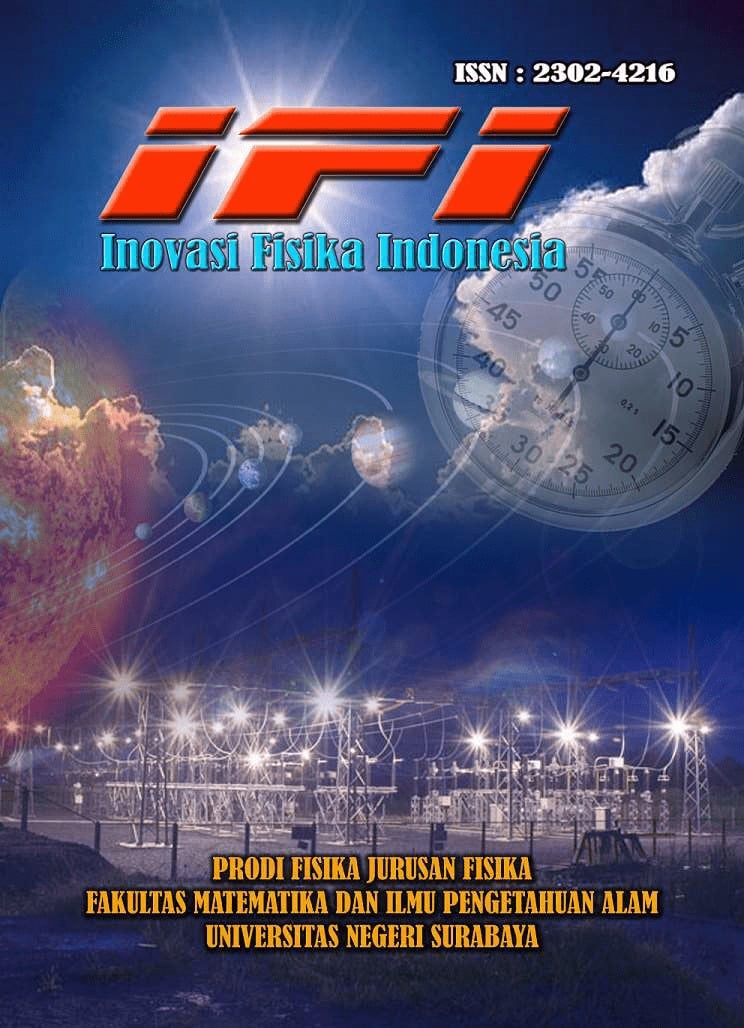ANALISIS KARAKTERISTIK KOMPOSIT PULP KERTAS DAN SERABUT KELAPA UNTUK PEMBUATAN BAHAN BAKU KERTAS RAMAH LINGKUNGAN
DOI:
https://doi.org/10.26740/ifi.v14n2.p141-151Keywords:
kertas daur ulang, Serat kelapa, komposit, uji tarik, sifat mekanik, daya serap, coconut fiber, recycled paper, composite, tensile test, Mechanical properties, AbsorbencyAbstract
Abstrak
Penelitian ini bertujuan untuk menganalisis karakteristik komposit pulp kertas daur ulang dan serat kelapa sebagai bahan baku pembuatan kertas ramah lingkungan. Proses penelitian mencakup persiapan pulp kertas dari kertas bekas dan serat kelapa yang diproses menjadi serbuk, yang kemudian dicampur dengan berbagai rasio massa (0:100, 20:80, 30:70, dan 40:60). Pengujian dilakukan untuk mengukur tebal, gramatur, daya serap air, dan kekuatan tarik kertas dengan mengacu pada standar (SNI 7274:2008) dan (SNI-ISO-1924-2-2016). Hasil uji tebal kertas menunjukkan bahwa perbedaan rasio massa tidak memberikan pengaruh signifikan terhadap tebal kertas, sebagian besar hasil komposit memiliki tebal rata-rata 0.13 mm. Pengujian selanjutnya berupa uji gramatur yang memberikan hasil sebesar 108 – 200 g/mm2, dari dua uji tersebut dapat digunakan untuk menghitung nilai bulk kertas. Hasil perhitungan bulk kertas menyatakan bahwa semua sampel telah memenuhi standart (SNI 7274:2008) yang memiliki nilai dibawah 1.5 cm3/gr. Komposisi serat kelapa dan pulp kertas (20:80) pada penelitian ini memiliki kuat tarik sebesar 2.73 kN/m dan daya regang 1.37% menjadi pilihan komposisi rasio paling optimal sesuai standar (SNI-ISO-1924-2-2016). Penambahan serat kelapa pada pulp kertas dapat meningkatkan kekuatan tarik melalui efek penguatan, sedangkan pada rasio serat yang lebih tinggi (>30), terjadi penurunan kualitas akibat distribusi serat yang tidak merata dan ikatan yang lemah dalam pulp kertas. Dengan demikian, hasil penelitian ini dapat dijadikan alternatif produk kertas daur ulang yang ekonomis yang memiliki karakteristik yang sesuai dengan standar yang telah ditentukan.
Abstract
This study aims to analyze the characteristics of recycled paper pulp and coconut fiber composites as raw materials for environmentally friendly paper production. The research process includes the preparation of paper pulp from waste paper and coconut fibers processed into powder, which is then mixed in various mass ratios (0:100, 20:80, 30:70, and 40:60). Tests were conducted to measure the thickness, grammage, water absorption, and tensile strength of the paper, referring to the standards (SNI 7274:2008) and (SNI-ISO-1924-2-2016). The paper thickness test results indicate that variations in mass ratio do not significantly affect the paper thickness, with most composite samples having an average thickness of 0.13 mm. The grammage test results ranged from 108 to 200 g/mm², and these two tests were used to calculate the paper bulk value. The bulk calculation results show that all samples met the SNI 7274:2008 standard, which requires a bulk value below 1.5 cm³/g. The 20:80 composition of coconut fiber and paper pulp in this study exhibited a tensile strength of 2.73 kN/m and an elongation of 1.37%, making it the most optimal ratio according to the SNI-ISO-1924-2-2016 standard. The addition of coconut fiber to paper pulp enhances tensile strength through a reinforcement effect, while higher fiber ratios (>30) result in a decline in quality due to uneven fiber distribution and weak bonding within the paper pulp. Therefore, the findings of this study provide an economical alternative for recycled paper products that meet the specified standards.
Downloads
References
BSN. (2008). Kertas cetak A. Standar Nasional Indonesia, 7274, 1–6.
Elfaleh, I., Abbassi, F., Habibi, M., Ahmad, F., Guedri, M., Nasri, M., & Garnier, C. (2023). A comprehensive
review of natural fibers and their composites: An eco-friendly alternative to conventional materials.
Results in Engineering, 19(April), 101271. https://doi.org/10.1016/j.rineng.2023.101271
Iso, S. N. I. (2016). H ]. Standar Nasional Indonesia, 1924-2-2016, 1–6.
Paskawati, Y. A., Susyana, Antaresti, & Retnoningtyas, E. S. (2020). Pemanfaatan tempurung kelapa sebagai
bahan baku pembuatan kerta komposit alternatif. Widya Teknik, 9(1), 12–21.
Saputra, A. Z., & Fauzi, A. S. (2022). Pengolahan Sampah Kertas Menjadi Bahan Baku Industri Kertas Bisa
Mengurangi Sampah di Indonesia. Jurnal Mesin Nusantara, 5(1), 41–52.
https://doi.org/10.29407/jmn.v5i1.17522
Setiyani, & Yulistiana. (2023). Pemanfaatan Limbah Sabut Kelapa Sebagai Pewarna Alami Pada Kain Katun.
E-Journal Edisi Yudisium, 12(1), 2–9.
Sundari, E. M., Suhendra, & Apriani, W. (2020). Uji Kekuatan Tarik Kertas Daur Ulang Campuran. Ilmiah
Teknik Mesin, 6(1), 28–33.
Wiyanto, E., Harsono, B., Makmur, A., Pangputra, R., Julita, J., & Kurniawan, M. S. (2017). Penerapan
Elektrokoagulasi Dalam Proses Penjernihan Limbah Cair. Jetri : Jurnal Ilmiah Teknik Elektro, 12, 19–36.
Downloads
Published
How to Cite
Issue
Section
License
Copyright (c) 2025 Pratiwi, Lydia Rohmawati, Evi Suaebah

This work is licensed under a Creative Commons Attribution-NonCommercial 4.0 International License.
 Abstract views: 268
,
Abstract views: 268
, PDF Downloads: 144
PDF Downloads: 144








1.png)
